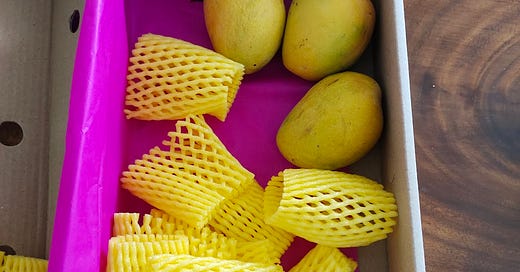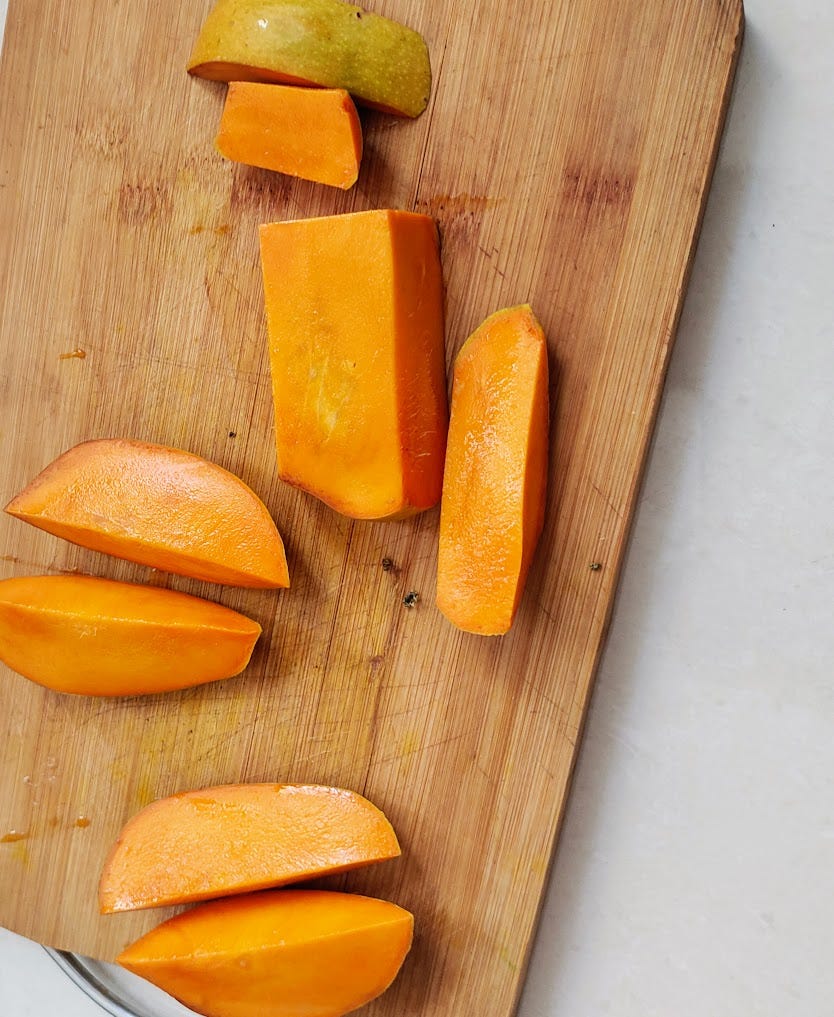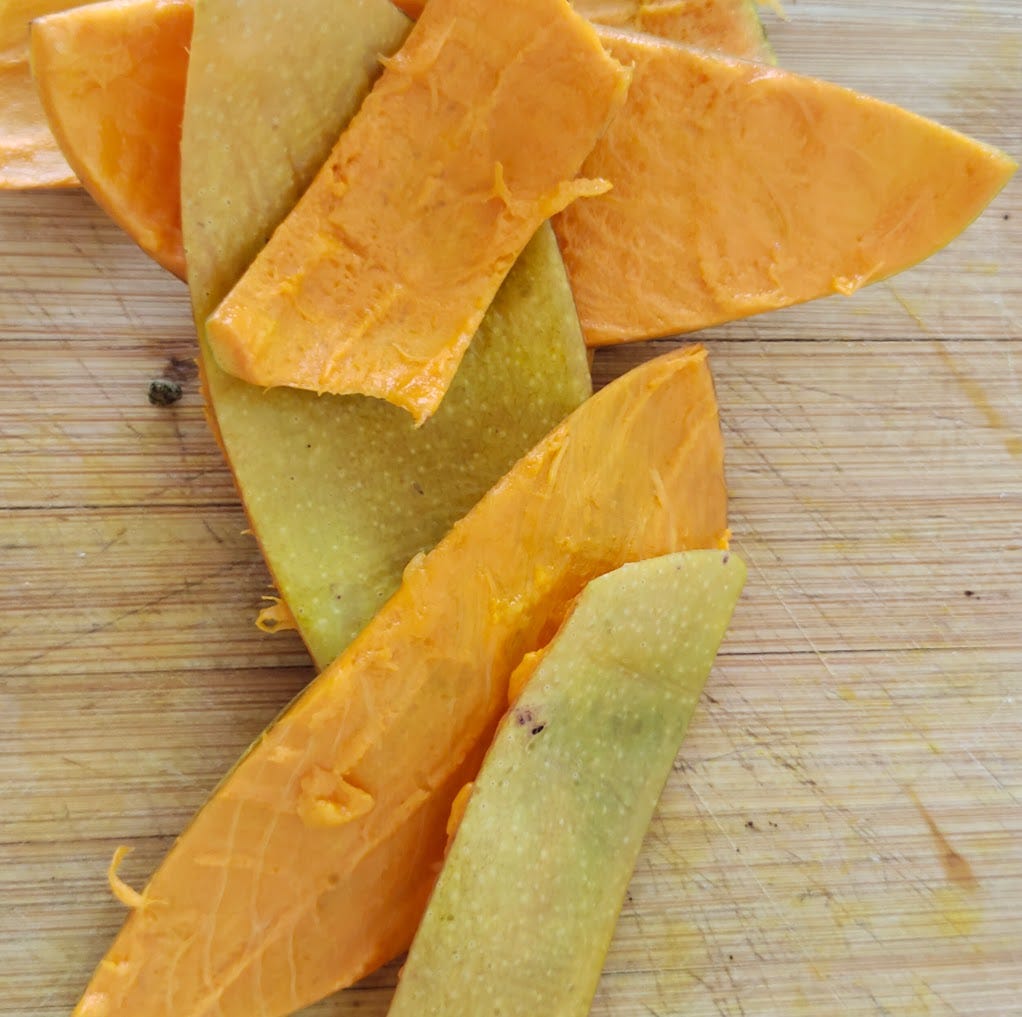“I don’t want to get into the mango debates” a fellow firangi said when mangoes first started appearing at markets. “I am sick of everyone telling me for years that it’s impossible to get a good mango in the U.S. or that the reason I don’t like mangoes is because I just haven’t had a good mango.”
You can imagine my cheeks tensing, then spreading into the press of a smile, then the only possible response: “Sounds like you’ve never had a good mango.”
But it’s fun, these chauvinisms. It’s a mode of belonging, obviously. This is kind of the most obvious thing about the mango— its metaphors so overexposed. (on which Apoorva Sripathi wrote beautifully! As did Soniah Kamal! With another nod here!)
(lol). I am the diaspora in reverse; I participate in mango-belonging transversely, at an angle. I don’t just live in InDiA, as though India were just one thing. I am writing to you from the terroir of the RATNAGIRI MANGO, the DEVGAD HAPUS, the king of mangoes, the best mango in the world! They thrive here and here only. They are intensely local when my life is so global. The weight of the hapus gives me leverage against friends who are nostalgic for the small, green, pulpy mangoes of their childhood Lucknowi summers. “Yeah, but…. hapus,” I retort. No Lucknowi childhood, no nani, no nostalgia. Still, she is forced to concede: “Yeah. OK. Hapus.”
Usually one class a semester, the students mutiny and decide to ask me personal questions about my life, and I let them because it’s fun and also I also kind of figure they deserve to know who it is in the room with them (see hooks, Teaching to Transgress). After the preliminaries— what did you study at university, what are you doing here?— comes another basic question: “do you eat Indian food?” or this time more specifically: “when you first came to India, what about the food surprised you?” or it was something like: “what Indian foods did you grow to love?”
MANGOES! Mangoes. I never got it, the South Asian mango thing, when people would say “it’s not a food, it’s a lifestyle.” The descriptions of mango pimples. Mango weight gained and shed each year. The Amir Khusrao riddle:
“He visits my town once a year.
He fills my mouth with kisses and nectar.
I spend all my money on him.
Who, girl, your man?
No, a mango.”
When buying my first crate of mangoes in India, the farmer asked whether our house had an air-conditioner. “Do not let the a/c touch the mangoes,” he cautioned. “The cold will ruin them.” Or when the mango tree at the family house bore fruit and we put the mangoes down between two blankets fashioned out of old saris, as though tucking them in to sleep. I hear daydreamy descriptions of eating mangoes right off the branch, but this is not my reality. Mangoes are plucked green then coddled— loved! really— into ripeness.
No one can describe an Alphonso mango, tell you in any specific terms why they are better than the Costa Rican mangoes you get at American supermercados, except maybe one tweet I saw one time, which read: “amazing how a good mango can contain so many other fruits.” I didn’t get it. And then, suddenly, I did.
Something that consistently amazes me about mangoes is that they contain the heat of the summer sun. A mango in its carton is hot to the touch. Hot to the touch. A mango is edible sunshine.
What do you eat when it’s 105 for days on end? What do you eat when you can’t bear to cook, when your body is wilting, when your appetite is shot? What do you eat once the apartment cools but its midnight and you’ve just gotten that subtropical second wind?
I thought maybe of highlighting amba poli (aam papad) in this newsletter, a local fruit-leather-like sheet of dried mango pulp. But the truth is, I am kind of off sweets lately. The aam papad carried by our local shop is half-sugar, it crumbles rather than pulls. When it’s hot like this, all I want is a mango.
And as my relationship with the city grows deeper, I can step off my Alphonso high horse (even though, come on! they are the best and everyone knows it, if you disagree you are kidding yourself or have perhaps never had a good mango?) and enjoy an aamras made with mostly pairi and a few hapus for (hear me out) snot-like contrast. I appreciate the incredible sour-candy-like hit of hulking, clod-like Rajapuri (obviously I mean this as a compliment) and even the end-of-season Kesars that come down from Gujarat, a little duller, less clever, more cloying.
There is something exigent about snacks— a snack fills a snack-shaped hole in your heart. You snack to meet a hunger. But there is also something extra: a snack is that which exceeds three squares a day. This is also the classic Freudian v Lacanian definition of desire, isn’t it? As lack, as excess. A mango in the summer on an empty stomach. The glory of the mango’s needless perfection, the another-and-anotherness. Both. And.








loved this! my dad *just* spoke about wanting to get Ratnagiri somehow this year lol